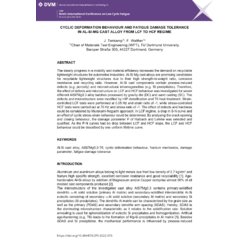- Online only



The steady progress in e-mobility increases the demand on lightweight space frame and engines solutions, especially in heavy hybrid-engines in automotive industries. Hereby, the cast alloys allow a near net-shape manufacturing including specific functionality related to local cooling fins or additional fixing points for automated production. Advanced aluminum-silicon cast alloys with additions of magnesium and/or cupper for precipitation hardening are promising candidates for lightweight structures due to their high strength-to-weight ratio. However, Al-Si cast components contain generally process-induced defects, i.e. porosity. Moreover, the Al-Si eutectic contains hard and stiff Si particles acting as stress raisers on microstructural level. Therefore, the porosity and eutectic Si…

Datenschutzbedingungen (bearbeiten im Modul "Kundenvorteile")

Lieferbedingungen (bearbeiten im Modul "Kundenvorteile")

Rücksendebedingungen (bearbeiten im Modul "Kundenvorteile")
The steady progress in e-mobility increases the demand on lightweight space frame and engines solutions, especially in heavy hybrid-engines in automotive industries. Hereby, the cast alloys allow a near net-shape manufacturing including specific functionality related to local cooling fins or additional fixing points for automated production. Advanced aluminum-silicon cast alloys with additions of magnesium and/or cupper for precipitation hardening are promising candidates for lightweight structures due to their high strength-to-weight ratio. However, Al-Si cast components contain generally process-induced defects, i.e. porosity. Moreover, the Al-Si eutectic contains hard and stiff Si particles acting as stress raisers on microstructural level. Therefore, the porosity and eutectic Si particles as well as their interaction have to be considered to analyze the fatigue behavior.
This study deals with the influence of dendrite arm spacing (DAS) and the morphology of the eutectic Si particles on the cyclic deformation behavior and the fatigue damage evolution in AlSi7Mg0.3-T6 aluminum cast alloys (A356-T6). Therefore, specimens were processed by die (DC) and sand casting (SC) resulting in small and large DAS as well as spherical- (DC) and flake-shaped (SC) eutectic Si particles. Strain-controlled incremental step (IST) and constant amplitude tests were carried out to study the cyclic deformation behavior, while the HCF and VHCF behavior was characterized under stress control. The measurement of fatigue-induced change in resonant frequency and electrical resistance by alternating current potential drop enables the separation in crack initiation and propagation phase. In LCF regime, large DAS and flake-shaped eutectic Si particles lead to a significantly reduced capacity of large strains from 0.9% for DC to 0.6% for SC alloy. Moreover, the fatigue crack initiation lifetime, which depends on plastic strain amplitude, is highly reduced in SC alloys by a factor of 5 to 10, while both alloys have a comparable lifetime to failure. The increased crack propagation lifetime in SC alloys correlates with a higher cyclic hardening potential obtained in cyclic indentation tests, indicating an increased damage resistance. Since the crack grows preferably interdendritic through the Al-Si eutectic, the increased damage resistance can be related to a barrier effect of large flake-shaped Si particles in SC alloy compared to the small spherical-shaped Si particles in DC alloy.